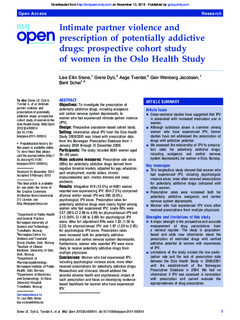| dc.contributor.author | Stene, Lise Eilin | |
| dc.contributor.author | Dyb, Grete | |
| dc.contributor.author | Tverdal, Aage | |
| dc.contributor.author | Jacobsen, Geir Wenberg | |
| dc.contributor.author | Schei, Berit | |
| dc.date.accessioned | 2015-11-10T11:22:17Z | |
| dc.date.accessioned | 2015-11-20T13:43:57Z | |
| dc.date.available | 2015-11-10T11:22:17Z | |
| dc.date.available | 2015-11-20T13:43:57Z | |
| dc.date.issued | 2012 | |
| dc.identifier.citation | BMJ Open 2012, 2(2) | nb_NO |
| dc.identifier.issn | 2044-6055 | |
| dc.identifier.uri | http://hdl.handle.net/11250/2365016 | |
| dc.description.abstract | Objectives:To investigate the prescription of potentially addictive drugs, including analgesics and central nervous system depressants, to women who had experienced intimate partner violence (IPV).
Design: Prospective population-based cohort study.
Setting: Information about IPV from the Oslo Health Study 2000/2001 was linked with prescription data from the Norwegian Prescription Database from 1 January 2004 through 31 December 2009.
Participants: The study included 6081 women aged 30–60 years.
Main outcome measures: Prescription rate ratios (RRs) for potentially addictive drugs derived from negative binomial models, adjusted for age, education, paid employment, marital status, chronic musculoskeletal pain, mental distress and sleep problems.
Results: Altogether 819 (13.5%) of 6081 women reported ever experiencing IPV: 454 (7.5%) comprised physical and/or sexual IPV and 365 (6.0%) psychological IPV alone. Prescription rates for potentially addictive drugs were clearly higher among women who had experienced IPV: crude RRs were 3.57 (95% CI 2.89 to 4.40) for physical/sexual IPV and 2.13 (95% CI 1.69 to 2.69) for psychological IPV alone. After full adjustment RRs were 1.83 (1.50 to 2.22) for physical/sexual IPV, and 1.97 (1.59 to 2.45) for psychological IPV alone. Prescription rates were increased both for potentially addictive analgesics and central nervous system depressants. Furthermore, women who reported IPV were more likely to receive potentially addictive drugs from multiple physicians.
Conclusions: Women who had experienced IPV, including psychological violence alone, more often received prescriptions for potentially addictive drugs. Researchers and clinicians should address the possible adverse health and psychosocial impact of such prescription and focus on developing evidence-based healthcare for women who have experienced IPV. | nb_NO |
| dc.language.iso | eng | nb_NO |
| dc.publisher | BMJ Publishing Group | nb_NO |
| dc.relation.uri | http://bmjopen.bmj.com/content/2/2/e000614.full | |
| dc.title | Intimate partner violence and prescription of potentially addictive drugs: prospective cohort study of women in the Oslo Health Study | nb_NO |
| dc.type | Journal article | nb_NO |
| dc.type | Peer reviewed | en_GB |
| dc.date.updated | 2015-11-10T11:22:17Z | |
| dc.subject.nsi | VDP::Medisinske fag: 700::Helsefag: 800::Samfunnsmedisin, sosialmedisin: 801 | nb_NO |
| dc.subject.nsi | VDP::Midical sciences: 700::Health sciences: 800::Community medicine, social medicine: 801 | nb_NO |
| dc.source.volume | 2 | nb_NO |
| dc.source.journal | BMJ Open | nb_NO |
| dc.source.issue | 2 | nb_NO |
| dc.identifier.doi | 10.1136/bmjopen-2011-000614 | |
| dc.identifier.cristin | 927198 | |
| dc.subject.keyword | Avhengighet / Addiction | |
| dc.subject.keyword | Kjønnsbasert vold / Gender based violence | |
| dc.subject.keyword | Legemidler / Drug development | |
| dc.subject.keyword | Parforhold / Relationship | |
| dc.description.localcode | This is an open-access article distributed under the terms of the Creative Commons Attribution Non-commercial License, which permits use, distribution, and reproduction in any medium, provided the original work is properly cited, the use is non commercial and is otherwise in compliance with the license. See: http://creativecommons.org/licenses/by-nc/2.0/ and http://creativecommons.org/licenses/by-nc/2.0/legalcode. | nb_NO |
